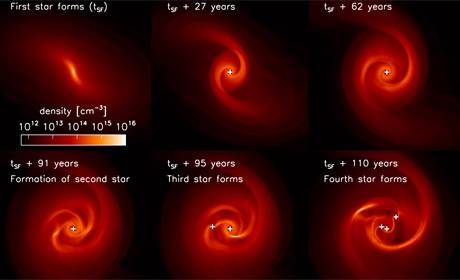|
The Well Balanced Universe |
|||
Astronomy newsFirst stars study contradicts big bang25 March 2011 Contrary to current thinking by big bang theorists, the first stars in the universe were not all solitary and massive. Rather, they probably formed alongside numerous companions when the gas disks that surrounded them broke up during formation, giving birth to sibling stars of various masses in the fragments. These are the findings of studies performed with the aid of computer simulations by researchers at Heidelberg University's Centre for Astronomy together with colleagues at the Max Planck Institute for Astrophysics in Garching and the University of Texas at Austin (USA). The group's findings, published in the journal Science, cast an entirely new light on the formation of the first stars after the Big Bang. Stars evolve from cosmic gas clouds in a fierce and complex battle between gravity and internal gas pressure. The density of the gas increases due to its own gravitational pull. This causes the gas to heat up, as a consequence the pressure rises, and the compression process comes to a halt. If the gas manages to get rid of the thermal energy, compression can continue and a new star is born. This cooling process works especially well if the gas contains chemical elements like carbon or oxygen. Stars forming in this way are normally low in mass, like our Sun. But in the early universe these elements had yet to emerge, so the primordial cosmic gas could not cool down very well. Accordingly, most theoretical models predict the masses of primordial stars to be about a hundred times greater than that of the Sun. This prediction of the models is seen as a solution to a serious observational difficulty for the big bang itself. One of the fundamental tenets of the theory is that only the three elements hydrogen, helium and lithium were created in the explosion, and that therefore the first stars were composed of nothing else. By far the most numerous stars in the universe are small and have lifetimes of tens or hundreds of billions of years. Consequently, it was expected that it should be relatively easy to find some of the first stars, composed purely of these three lightest elements, still around today. Despite decades of searching, however, not a single one has been discovered. The only viable explanation given is that all the first stars must have been very massive, because such stars have very short lifetimes and so none would be around now. The models, therefore, were seen as fundamental support for the theory. Heidelberg astrophysicist Dr. Paul Clark and his colleagues decided to investigate these processes of early star formation with the help of very high resolution computer simulations. Their findings indicate that the simple picture where only massive stars are produced needs to be revised and that the early universe was not only populated by huge, solitary stars. The reason is the underlying physics of the so called accretion disks accompanying the birth of the very first stars. The gas from which a new star forms rotates, and so the gas is unable to fall directly onto the star, but first builds up a disk-like structure. Only as a result of internal friction can the gas continue to flow onto the star. If more mass falls onto this disk than it can transport inwards, it becomes unstable and breaks into several fragments. So instead of forming just one star at the centre, a group of several stars is formed. The distances between some of the stars can be as small as that between Earth and the Sun. Some of the first stars would have been catapulted out of their birth group through collisions with their neighbours before they were able to accumulate a great deal of mass. "Intriguingly," says Dr. Clark, "some low-mass primordial stars may even have survived to the present day, allowing us to probe the earliest stages of star and galaxy formation right in our own cosmic backyard."
According to Dr. Clark, the study also opens up new avenues for detecting the first stars in the universe. In the final stages of their lives, binaries or multiple stellar systems can produce intense bursts of X-rays or gamma rays. Future space missions are being planned specifically to investigate such bursts from the early universe. So, will any of these first stars be found? Certainly the clock is ticking for the standard model of the universe. Together with Dr. Simon Glover and Dr. Rowan Smith, Dr. Paul Clark is a member of the star-formation research group headed by Prof. Dr. Ralf Klessen at Heidelberg University's Centre for Astronomy. Also involved in the research were Dr. Thomas Greif of the Max Planck Institute for Astrophysics (Garching) and Prof. Dr. Volker Bromm of the University of Texas. This research was funded by the Baden-Württemberg Foundation as part of the International Top-Level Research II programme. Additional support came from the FRONTIER innovation fund of Heidelberg University as well as the German Research Foundation, the US National Science Foundation, and NASA. |
|
||
More news ...
|
|||
